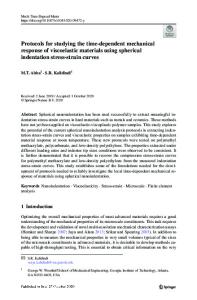Indentation method for measuring the viscoelastic kernel function of nonlinear viscoelastic soft materials
- PDF / 805,312 Bytes
- 11 Pages / 584.957 x 782.986 pts Page_size
- 76 Downloads / 383 Views
The indentation method of nonlinear viscoelastic materials is investigated through combined numerical and experimental efforts to reveal the correlation between the viscoelastic kernel function and the indentation responses. It is shown that the viscoelastic kernel function of a nonlinear viscoelastic solid with viscous response characterized by a linear rate constitutive equation scales with the normalized relaxation load in an indentation relaxation test. This scaling relation does not depend on the geometry of the indented solid and the profile of the indenter. Therefore, it may serve as a fundamental relation for characterizing the viscoelastic properties of some biological soft tissues and artificial soft materials with regular/irregular surface morphology. I. INTRODUCTION
Determining the mechanical properties of soft materials (e.g., biological soft tissues and soft elastomers) is of great importance and has received considerable attention of scientists and engineers from various disciplines. For instance, the knowledge on the mechanical properties of soft biomaterials is crucial for tissue engineering and for understanding the responses of cells or tissues to mechanical stimuli.1 Within the framework of continuum mechanics, soft materials may be modeled by linear elastic, hyperelastic elastic, linear viscoelastic, nonlinear viscoelastic, poroelastic, or other sophisticated biphasic/multiphasic constitutive relations, depending on the parameters and deformation behavior that are concerned.2–6 Although quite a few methods have been proposed to determine the mechanical properties of soft materials, it remains a challenge to perform regional mechanical tests, especially at small scales.6 Recent studies have demonstrated that instrumented indentation is a powerful tool for mechanical characterization of soft materials. For example, Shimizu et al.7 and Lu et al.8 have established the methods to analyze the indentation of linear viscoelastic materials based on the viscoelastic contact theory. Their method can be applied to the mechanical characterization of polymeric materials. Fischer-Cripps9 discussed the possibility to use the multiple frequency responses in dynamic indentation for the mechanical characterization of viscoelastic materials. Tang and Ngan10 explored the indentation of power law viscoelastic materials, and recently, they reported a rate-jump method for characterization of soft tissues using nanoindentation.11 Oyen and Cook12 studied the correlation between the indentation responses and material properties for a)
Address all correspondence to this author. e-mail: [email protected] DOI: 10.1557/jmr.2012.431 806
J. Mater. Res., Vol. 28, No. 6, Mar 28, 2013
http://journals.cambridge.org
Downloaded: 14 Mar 2015
the indentation of viscous–elastic–plastic materials. Oyen13 investigated indentation creep tests and proposed a method to reduce the errors caused by the rising time. In their excellent review paper, Cheng and Cheng14 showed how the dimensional analysis method could be used to deal
Data Loading...











